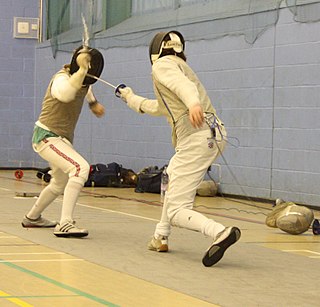This article needs additional citations for verification .(August 2023) |
Fencing at the high school level has varied in popularity.
This article needs additional citations for verification .(August 2023) |
Fencing at the high school level has varied in popularity.
In many European}
Fencing was once a part of many schools' physical education (PE) curriculum, and many schools had clubs and would compete in inter-school tournaments. In the second half of the 20th century, fencing gradually faded from physical education curricula in the United States. This has been attributed to worries about 'weapons in schools' or that it requires expensive equipment. Fencers dispute the characterization of fencing foils as weapons since they fail to meet the applicable criteria - a tool of injury or destruction - since foils are engineered specifically to contact the human body without injury.[ citation needed ]
However, youth fencing has remained a club sport at some schools, and the last several years have seen an increase in fencing clubs and tournaments at the high school level. The United States Fencing Association has encouraged this through the Regional Youth Circuit program. [1] High school fencing season is generally in winter. [2]
High school fencing has also gained a renewed following in the United States, evidenced by the establishment of state leagues, and an increase in Junior level national competitors.[ citation needed ]
High school competitive fencing has grown significantly in the state of New Jersey, one of the few states where it remains a varsity sport. The league is growing steadily, and there are currently 55 varsity programs in the state. [3] The New Jersey Interscholastic Fencing Association includes Montgomery High School, The Pingry School, Voorhees High School, and more.
Georgia in particular has seen growing interest in high school fencing. The Georgia High School Fencing League was founded in 2004 and in the 2013–14 season numbers 17 schools and over 350 fencers. Member schools hold their own practices and come together about once a month during the fall and winter seasons to fence other member schools, primarily in épée. Additionally, the On Guard High School League of Georgia was created to allow high school fencers to fence all three weapons (épée, foil and sabre). This league was formed in 2010 in the 2012–13 season numbered seven schools and over 150 fencers.[ citation needed ]
The North Carolina Fencing League has grown to include Chapel Hill High School, Elkin High School, Morehead High School, East Chapel Hill High School, the North Carolina School of Science and Mathematics, Bishop McGuinness High School in Kernersville, Cape Fear Fencing Association of Wilmington, Salem Academy, Epiphany School of Global Studies, Reynolds High School and even a non-North Carolina school, Carlisle Preparatory Academy in Martinsville, Virginia. The latest champion of the league is East Chapel Hill High.
The Great Lakes High School Fencing Conference, consisting of schools in Illinois, Wisconsin and Indiana, was founded in 1981. Current information about GLHSFC membership, rules and competition schedules can be found on the New Trier HS Fencing Team page. [4]
There is also a detailed history of high school fencing in Illinois from 1903–2013, written by Robert Prueter, on the web site of the IHSA (Illinois High School Association) [5] - "Fencing: A Long-time Illinois Sport". [6]

Fencing is a combat sport that features sword fighting. The three disciplines of modern fencing are the foil, the épée, and the sabre ; each discipline uses a different kind of blade, which shares the same name, and employs its own rules. Most competitive fencers specialise in one discipline. The modern sport gained prominence near the end of the 19th century and is based on the traditional skill set of swordsmanship. The Italian school altered the historical European martial art of classical fencing, and the French school later refined that system. Scoring points in a fencing competition is done by making contact with an opponent.

A foil is one of the three weapons used in the sport of fencing. It is a flexible sword of total length 81.2 cm (32.0 in) or under, rectangular in cross section, weighing under 500 g (18 oz), with a blunt tip. As with the épée, points are only scored by making contact with the tip. The foil is the most commonly used weapon in fencing.

The épée, sometimes spelled epee in English, is the largest and heaviest of the three weapons used in the sport of fencing. The modern épée derives from the 19th-century épée de combat, a weapon which itself derives from the French small sword.
Classical fencing is the style of fencing as it existed during the 19th and early 20th centuries. According to the 19th-century fencing master Louis Rondelle,
A classical fencer is supposed to be one who observes a fine position, whose attacks are fully developed, whose hits are marvelously accurate, his parries firm, and his ripostes executed with precision. One must not forget that this regularity is not possible unless the adversary is a party to it. It is a conventional bout, which consists of parries, attacks, and returns, all rhyming together.

The sabre is one of the three disciplines of modern fencing. The sabre weapon is for thrusting and cutting with both the cutting edge and the back of the blade.

Fencing – family of combat sports using bladed weapons. Fencing is one of four sports which have been featured at every one of the modern Olympic Games. Also known as modern fencing to distinguish it from historical fencing.

Ranney School is an independent coeducational, college preparatory day school for students from age 3 (Beginners) through twelfth grade located in Tinton Falls, New Jersey, United States.

The flèche is an aggressive offensive fencing technique used with foil and épée.
The Amateur Fencers League of America (AFLA) was founded on April 22, 1891, in New York City by a group of fencers seeking independence from the Amateur Athletic Union. As early as 1940, the AFLA was recognized by the Fédération Internationale d'Escrime (FIE) and the United States Olympic Committee as the national governing body for fencing in the United States.
The Intercollegiate Fencing Association (IFA) was the oldest collegiate fencing conference in the United States. It was affiliated with the Eastern College Athletic Conference (ECAC).
Fencing practice and techniques of modern competitive fencing are governed by the Fédération Internationale d'Escrime (FIE), though they developed from conventions developed in 18th- and 19th-century Europe to govern fencing as a martial art and a gentlemanly pursuit. The modern weapons for sport fencing are the foil, épée, and sabre.
Harold David Goldsmith, known as Hal was an American Olympic foil and epee fencer.
Byron Lester Krieger was an American foil, sabre and épée fencer. Krieger represented the United States in the Olympics in 1952 in Helsinki and 1956 in Melbourne, and in the 1951 Pan American Games where he won two gold medals.
The oldest surviving manual on western swordsmanship dates back to the 14th century, although historical references date fencing schools back to the 12th century.

Collegiate fencing in the United States can be traced back to as early as 1941. Some of the earliest programs in the US came from the Ivy League schools, with the first Ivy League fencing championships taking place in 1956. As of 2023, there are 112 club teams, 43 women's varsity fencing programs and 33 men's varsity teams in the US. Both clubs and varsity teams participate in the sport, however only the varsity teams may participate in the NCAA championship tournament. Due to the limited number of colleges that have fencing teams, NCAA fencing combines the three divisions into a combined National Collegiate sport, all participating in one NCAA Championship.
The British Academy of Fencing (BAF) is a membership organisation for those involved in coaching and coach education in the sport of fencing in the United Kingdom. The Academy claims to trace its roots to the reign of Henry VII and the Company of Masters of the Science of Defence, and was established in 1949.
Bennet Nathaniel Lubell was an American three-time Olympian fencer.
Norman Lewis was an American Olympic épée fencer, who also competed in foil.
Abram "Abe" DreyerCohen was an American Olympic foil, épée, and sabre fencer.
Sergey Olegovich Bida is a Russian left-handed épée fencer, three-time European épée team champion, and 2021 Olympic épée team silver medalist. He was ranked #1 in the world in 2020. He moved to the United States in June 2023, along with his wife, Olympic épée fencer Violetta Khrapina Bida. Bida is a member of USA Fencing.